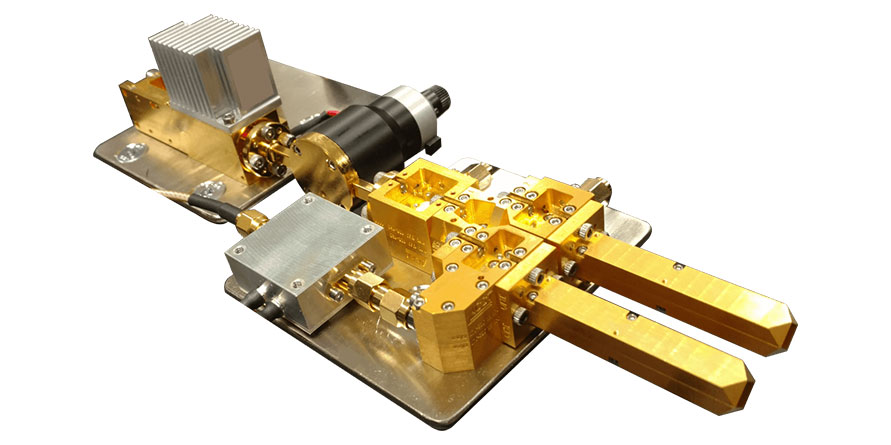300 GHZ Transceiver
Complementary to the broadband transceiver systems ACST has created the “High Performance Transceivers” exhibiting higher output on the transmitter side yet narrower bandwidth. They are the choice where high attenuation in traversion is anticipated.
High power systems feature up to 10 dB more output power in comparison to the broadband systems!
While applying the same receiver technology these systems are capable of maintaining dynamic range or signal to noise ratio when absorption of the emitted mm-wave is an issue.
These systems require a low frequency signal source, typically up to 20 GHz for input, which is multiplied to the desired frequency range.
They readily follow source sweep and modulation schemes or may be used in CW mode where an off-set IF may be adjusted to fit into a customers IF-scheme for signal analysis.
Available configuration
| Techn. Specifications | Minimum | Typical | Maximum |
|---|---|---|---|
| Input Port | K-type (F) connector | ||
| Input Power (mW) | 5 | 10 | |
| Input Freq. Signal (GHz) | 11.45 | 13.125 | |
| Output Tx Port | WR-3.4 | ||
| Output Tx Power (mW) | 10 | 30 | 40 |
| Output Tx Freq. (GHz) | 275 | ||
| Input Rx Port | WR-3.4 | ||
| Input Rx Power (mW) | 0.1 | ||
| Input Rx Freq. (GHz) | 275 | 315 | |
| Rx Noise Figure (dB) | 8 | 9 | 11 |
| Rx IF Output Port | SMA (F) connector | ||
| IF LNA Gain (dB) | 45 | 46 | |
| LNA Noise Figure (dB) | 1.8 | 1.9 | 2.0 |
| IF Output Freq. (MHz) | 0.01 | 500 |
340 GHZ Transceiver
ACST features a set of broadband transceiver systems currently up to 750 GHz which may be seen as “state of the art” with respect to their bandwidth, output power and possible dynamic range.
The term “broad bandwidth” not only applies to the transmit and receiver part but also to the Intermediate frequency which may be retrieved from the receiver mixer, reaching up to 40 GHz.
These systems require a low frequency signal source, typically up to 20 GHz, for input, which is multiplied to the desired frequency range.
They readily follow source sweep and modulation or may simply be used in a CW mode, thus being highly versatile.
Available configuration
| Techn. Specifications | Minimum | Typical | Maximum |
|---|---|---|---|
| Input port | K-type (F) connector | ||
| Input Power (mW) | 5 | 10 | |
| Input Freq. Signal (GHz) | 12.91 | 14.34 | |
| Output Tx Port | WR-2.8 | ||
| Output Tx Power (mW) | 10 | 20 | 30 |
| Output Tx Freq. (GHz) | 310 | 340 | |
| Input Rx Port | WR-2.8 | ||
| Input Rx Power (mW) | 0.1 | ||
| Input Rx Freq. (GHz) | 310 | 340 | |
| Rx Noise Figure (dB) | 8 | 9 | 11 |
| Rx IF Output Port | SMA (F) connector | ||
| IF LNA Gain (dB) | 45 | 46 | |
| LNA Noise Figure (dB) | 1.8 | 1.9 | 2.0 |
| IF Output Freq. (MHz) | 0.01 | 500 |
Further models will follow shortly. Subscribe now to our newsletter to learn about new product releases.
ACST reserve the right to change the information presented here without notice.



